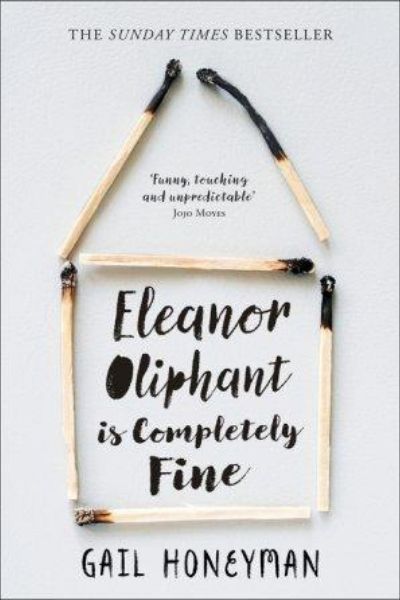7 Books You Never Knew Were About Mental Health
updated on Dec 6, 2019

We’ve all heard of the classics – Fight Club, The Perks of Being A Wallflower, Trainspotting – but are there other great books out there with mental health undertones that we’ve been overlooking all along?
It’s no real surprise to learn that reading isn’t only an enjoyable past time, but it can also be good for our health and wellbeing. Research has shown that reading can not only help to improve our memories, but can increase our empathy, make us feel better, and helps us to feel less stressed and more positive.
According to one study published in Science magazine, reading literary fiction can help us to relate more easily with others. Researchers revealed that literary fiction may have the power to help us better understand what others are thinking, helping us to read their emotions.
The more we read about people with different life experiences and beliefs than our own, the better we are able to understand them
The more literary fiction we read, the better we may be able to understand other’s mental states – a “crucial skill that enables the complex social relationships that characterise human societies”.
In essence, the more we read about people with different life experiences and beliefs than our own, the better we are able to understand them.
If that is the case, could reading more about other’s experiences with mental illness help increase our understanding of these complex conditions and situations? Could our existing understanding be, in part, thanks to the subtle inclusion of these themes and events in books we have read and enjoyed in the past?
We share seven books with subtle mental health themes you may have missed.

Jump to: Alcholism and gaslighting - The Girl on the Train | ADHD, GAD, Depression and more - Hundred Acre Woods | PTSD, childhood trauma and abuse - Harry Potter | Loneliness and alcholism - Elanor Oliphant is Completely Fine | Narcissism - Snow White | Stockholm syndrome and domestic abuse - Beauty and the Beast | Antisocial personality disorder and survivors guilt - We Need to Talk About Kevin
Alcholism and gaslighting - The Girl on the Train

Paula Hawkins’s runaway success The Girl on the Train hit the best-seller list worldwide, seeing translations released in 40 countries, as well as a major film adaptation. If you haven’t already read the book (it really is a modern classic), you may be unaware of two of the major, underlying themes: alcoholism and gaslighting.
Following the story of Rachel, a woman who gets the same commuter train each day, she catches glimpses of the perfect lives of the people who she passes by. Until one morning, during a fleeting moment, she sees something shocking, before the train continues on.
Filled with emotional abuse and attempts to self-medicate through alcohol consumption, the plot of the book is actually fairly different from the big screen adaptation. Rachel, the central protagonist, is a sad, lonely alcoholic who drinks tinned gin and tonic to get blackout drunk. An unreliable narrator, readers are often left unsure of what is the truth, and what may be down to her drinking.
As the narrative progresses, we see the reactions of those around Rachel to her increased problem with addiction. Her roommate Cathy (who has, for all intents and purposes, been a wet blanket) becomes unable to ignore her drinking.
Without giving too much away, gaslighting – a form of emotional abuse and psychological manipulation – can be seen as an underlying theme throughout. If you’re unfamiliar with the concept, gaslighting generally refers to when someone tries to manipulate your memory of events, to convince you (or a group of others) that something they know is true or experienced first hand, isn’t what happened. Over time, this can impact someone’s self-esteem and confidence, cause them to second-guess themselves, and even lead to them questioning their own sanity.
At its core, The Girl on the Train is about addiction and emotional abuse. We see first-hand what it is like to be so consumed by addiction, that it can affect every aspect of your life. Joining Rachel on her journey, we discover what it is like to be unable to trust even your own memories. A suspenseful thriller, it captures your attention and keeps you hooked (even if you know the big twist).
ADHD, GAD, depression and more - Return to Hundred Acre Woods

You may have seen listicles floating around online, claiming each of the Winnie the Pooh characters represent a different mental illness. But did you know that the idea first came across thanks to a journal article released by Doctor Sarah Shea and a team of her fellow paediatricians?
Published in 2000, Shea et al. explore the idea that A. A. Milne’s multi-generation loved book isn’t about the innocent world it first appears to be. According to their paper, each character meets the diagnosis criteria for a significant developmental disorer or mental illness.
Pooh himself exhibits many of the signs of attention deficit hyperactivity disorder (ADHD), as he often appears restless, impulsive, hyperactive, or struggles to concentrate. Obsessive compulsive disorder (OCD) is another potential diagnosis attributed to the beloved bear, as he has a high level of focus on food and repetatively counting things (though these can often be seen as stereotypes of OCD).
Piglet, unsurprisingly, can be attributed to exhibiting classic signs of generalised anxiety. Often seeming nervous and on edge, anxious, and overtly worried during day-to-day happenings, Piglet’s anxiety around a wide variety of situations and issues fits within the scope of GAD.
With other characters recieving speculative diagnosis ranging from dyslexia to depression, the original paper is worth a read (though it may make you see some of your favourite childhood characters with fresh eyes).

PTSD, childhood trauma and abuse - Harry Potter
In many respects, the entire Harry Potter series is one long, heartbreaking look into a young boy’s struggle to find love, acceptance, and his place in the world after a childhood filled with hatred and abuse.
It’s easy to overlook the glaring warning signs that something isn’t quite right with Harry’s home life. With the excitement of magic, adventures, mysteries, and attempted murder cropping up in each volume of the book, readers can understandably forget to question some of the big warning signs we see (though I still wonder how no one on the wizarding world picked up on them).
In Harry Potter and the Philosopher’s Stone, we discover Harry’s childhood bedroom is a literal cupboard under the stairs. In Harry Potter and the Chamber of Secrets, Harry is locked in a spare room with bars over the windows, a catflap allowing his meagre meals to be delivered to him with minimal interaction, and only being let out for chores and to use the bathroom. When warned of imminent danger to his health, Harry would rather face the unknown threat than the thought of an inescapable future with his abusive relatives.
The failure in Harry’s care doesn’t stop with the Dursley’s. As he runs away from home in Harry Potter and the Prisoner of Azkaban, we see weeks spent alone without adult supervision or care and attention being given to the young man. Is there no wizarding equivalent of social services, or has he just fallen through the cracks?
Speaking of which - how does he return, summer after summer, with no access to his books to complete homework or read ahead, less access to food than he has at school, often with more injuries or signs of his cousin’s ‘Harry hunting’, and nothing comes of it? We know at least three of the Weasleys witness Harry’s living conditions when they rescue him from Privet Drive. Do they just assume this is normal muggle behaviour?
In addition to the multitude of ways we see signs of childhood trauma and abuse going on to affect Harry’s trust of adults and authority figures around him as he grows, some fans feel that the Harry Potter series is actually one long story about PTSD. Rereading the series as an adult, underlying and overt themes of bereavement, the pain of loss, the effects of the horrors of war, along with the emotional scars that can be inflicted by prolongued trauma, are all present.
Post traumatic stress disorder (PTSD) can involve reliving the emotions of a past traumatic experience, having physical sensations such as anxiety, hearing or smelling things from your past experience, seeing visual flashes or images that feel real. Feeling on edge, guilty or isolated, as well as avoiding certain feelings or memories can all be common. A kind of anxiety disorder, PTSD can affect anyone, at any time, who has experienced any kind of traumatic event.
Throughout J. K. Rowling’s series, we see many aspects of Harry’s life being identified by traumatic events. If you’ve already read the book and aren’t worried about any potential spoilers, Sarah Gailey has written a great analysis of each of the books in the series and how they can be seen through the lense of PTSD over on Mashable, which is highly worth reading.

Loneliness and alcholism - Elanor Oliphant is Completely Fine
Gail Honeyman’s award-winning debut novel was an instant best-seller. Featured as part of the 2018 Mood Boosting Books list by the Reading Well Scheme, the novel topped the Sunday Times Best-Sellers list, going on to win Book of the Year at the British Book Awards, and becoming a fast favourite among readers.
While some fans have questioned if the titular character Eleanor may be on the spectrum, the author herself hopes that her novel has helped to fuel the debate about loneliness. When speaking about loneliness, traditionally many may have thought of elderly people living alone, yet more recent research by the Office of National Statistics has revealed that young adults aged 16–24 are amongst the most likely to feel lonely often or always.
Living a simple, predictable life, Eleanor wears the same clothes, eats the same meal, and buys the same two bottles of vodka (a potential sign of binge drinking and alcholism) each weekend. Happy with her carefully timetabled life, one simple act of kindness leads Eleanor to learn how to navigate the world, face the dark corners she’s avoided her whole life, and embrace change to discover something better than just being 'fine'.
As the titular character Eleanor herself says: “These days, loneliness is the new cancer – a shameful, embarrassing thing, brought upon yourself in some obscure way. A fearful, incurable thing, so horrifying that you dare not mention it.”
In an age of social media, where chatting with someone across the globe is just a few clicks or swipes away, in many ways it is inconceviable that so many of us still feel lonely and isolated. As the stigma around many mental health and wellbeing issues begins to lesson, our worries around emotional and social loneliness can still feel overwhelming.
As Eleanor explains, many feel that their lonelieness is, somehow, their own fault. While all of us will experience periods of loneliness during our lifetimes – be it when we lose a loved one, move, change schools or jobs – it can be tough to figure out how we can better understand lonleness, discover how to manage and overcome these feelings.

Narcissism - Snow White
Whether you’ve read the original fairytale by the Brother’s Grimm or watched one of the many more modern adaptations, the tale of Snow White is one many of us will have encountered during our childhoods.
Originating from an old folktale, the more modern version we read and see retold today is in many ways a distillation of countless iterations of the original. Changing gradually over time with new interpretations and iterations guiding how it is told and retold, the underlying themes remain.
Growing up with her ‘wicked stepmother’, we see that Snow White’s new mother is, in many ways, obsessed with youth and beauty; her drive for recognition and being acknowledged as the most fair pushing her to take drastic actions.
Though the wicked stepmother’s actions in many ways lead to positive developments – Snow White is pushed to grow up, leave home, develop new life skills, discover more about herself, all while testing her emotional resilience – it does bring to light more questions when approaching the tale from an adult perspective. If we put aside the notions of good and evil that we are prone to falling back on when explaining motivations in children’s stories, what, then, drives her stepmother?
In many ways, the wicked stepmother can be seen as portraying multiple narcissistic traits and behaviours. As counsellor David explains: “Narcissism is actually about promoting a false sense to cover the real, damaged and hurt self.”
Narcissistic behaviours and tendencies can include an inflated sense of importance and occasional, severe feelings of inferiority; manipulation and objectification of others; pride or high levels of jealousy; as well as a tendancy to rage for little objective cause. Obsessed with her own looks and beauty, seeking constant validation and reassurance of her place at the top, not to mention her high levels of jealousy of her younger, objectively more beautiful stepdaughter, the wicked stepmother can be seen as embodying many of these behaviours.

Stockholm syndrome and domestic abuse - Beauty and the Beast
Another much-beloved, often retold classic, Beauty and the Beast may be a tale as old as time, but readers are unable to agree on whether or not Belle exhibits classic symptoms of Stockholm syndrome.
Cut off from her friends and family, Belle is initially kept prisoner behind literal bars as her captor flies into unpredictable rages, destroying things and threatening to withold food. While Belle chooses to sacrifice her own freedom to take her father’s place, modern readers can easily see how Belle may begin sympathising with her captor as an attempt to make the best of her situation.
This trauma bond can be misinterpreted as feelings of love or closeness, as it can be safer for victims of abuse (in Belle’s case, the emotional, forced seperation from all of those she holds dear, underlayed with threats of physical violence and verbal rage) to bond with their abuser, rather than risking challenging them.

Antisocial personality disorder and survivors guilt - We Need to Talk About Kevin
Adapted for the big screen, Lionel Shriver’s modern classic We Need To Talk About Kevin looks at a side of school shootings we rarely see in the media - the long-running events leading up to the final act, as well as the aftermath for the family of the shooters.
A tough book to read, protagonist Eva never really wanted to be a mother – much less the sole survivor of her eldest child’s rampage that left seven classmates dead.
Set two years after the event, we see hints not only of what appears to have been warning signs of antisocial personality disorder throughout Kevin’s childhood, but are also faced with Eva’s own guilt and turmoil. Did her lack of desire to become a mother somehow affect Kevin growing up? Did her own dislike of him drive him towards his choices? Could she have done more to prevent the tragic events that have happened?
In their analysis of the film adaptation, Mental Health America calls the film a “vivid picture of the evolution of psychopathy”. Throughout, we see Kevin’s anger towards others, repeated manipulative and irresponsible behaviour, and overall uncaring personality. While he is able to cover his behaviours around his father, his mother seems to see right through him.
Thinking of a book that we missed out? Let us know your fav book (and how it's really about mental health) in the comments below, or tag us on social and we'll check it out.

